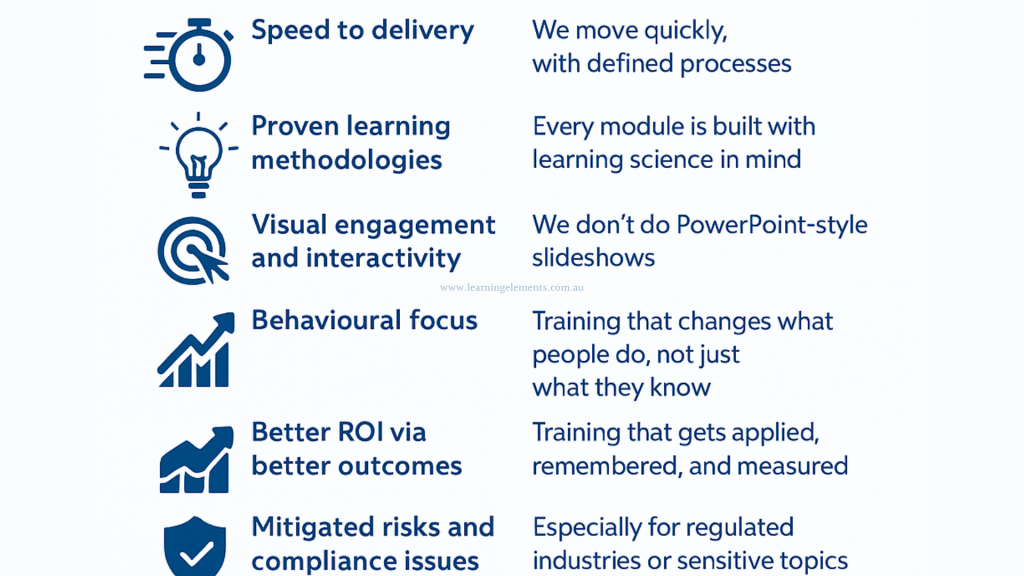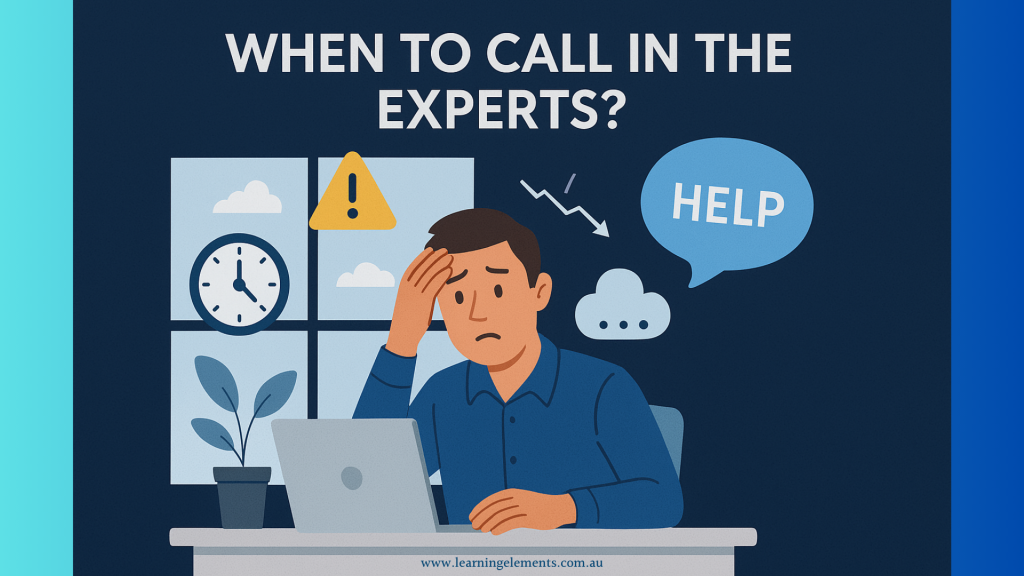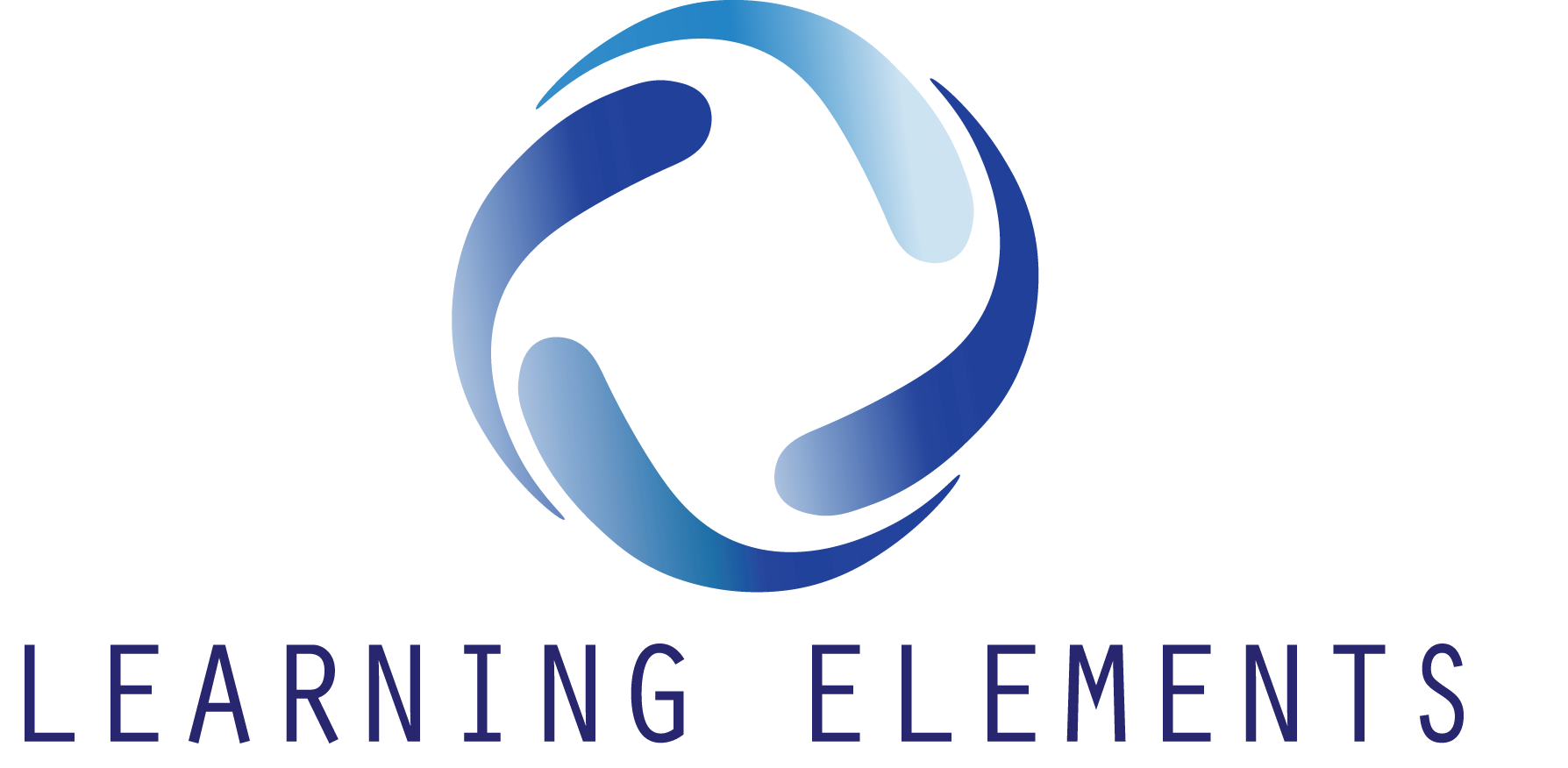Build vs Buy: Should You Develop E-Learning In-House or Partner with Experts?
Many organisations spend time and budget producing e-learning that ends up feeling like a glorified PowerPoint. Completion rates stay low, feedback is negative, and learning outcomes remain unclear. If your team is still creating ‘click-next’ courses with minimal engagement, it’s time to reassess. This is known as the classic build vs buy decision in learning design—and it’s more critical than ever to get it right. This article looks at the key question: should you build e-learning internally or buy it from external experts? We’ll weigh the pros and cons of each approach and help you decide whether in-house development or working with a partner like Learning Elements is the better fit for your team, your learners, and your results.
Build vs Buy: What’s the Best Approach to E-Learning?
Before diving into the pros and cons, let’s define what’s at stake in the build vs buy debate. ‘Building’ means developing training internally with your own tools and people. ‘Buying’ means working with a learning partner who delivers end-to-end solutions. Each path has pros, risks, and ideal use cases.
Evaluating Hybrid Options
Many organisations find that a hybrid approach—building core modules in-house while buying specialised content—offers the best of both worlds. This lets you maintain brand consistency without compromising quality in areas like compliance training or advanced technical learning.
Australian Hybrid E-Learning in Action: St George Bank Case Study
Australia’s St George Bank implemented a hybrid learning strategy blending internal development with external expertise. In a Macquarie University–backed case study, the bank adopted a mix of in-house training and blended modules created externally and found that combining these approaches helped scale e‑learning effectively across its teams. sproutlabs.com.au researchers.mq.edu.au.
Key outcomes from St George’s model:
- A robust business case built around blended learning to meet both cost and engagement goals
- Mandated early-stage content delivery with gradual shift towards more flexible, adaptive learning formats
- Use of both internal “core” modules and outsourced content for regulatory and technical topics, yielding stronger learner commitment
Why it works:
- Maintains brand alignment and internal expertise
- Leverages external partners for depth and quality in specialist domains
- Reduces rework and improves learner outcomes over time
When In-House Development Might Work
There are scenarios where internal development is viable:
- Basic internal comms updates
- Short compliance refreshers
- Organisations with experienced instructional designers on staff
If your content is static, non-critical, and low-risk, building in-house might be efficient. You know your content best, and you may already have someone who can use authoring tools like Articulate or Rise.
But that’s where it often ends.
The Risks of In-House E-Learning
Even when the intention is good, the result is often underwhelming. Common problems:
- Limited instructional design skills
- Poor visuals
- Lack of learner testing
- No time, no process = rushed, ineffective modules
Without a proper learning strategy, teams produce content-heavy screens, no interactivity, and learners clicking blindly through. That’s not learning—it’s ticking boxes.
In‑House Risk Checklist – Have You Considered:
- A detailed project timeline and workflow?
- Learner personas and usability testing?
- Multimedia and designer review processes?
- Support or maintenance over time?
Not sure where your risks are?
Get a free review of your training programs and let’s create awesome learning that works!
What Happens When Training is Ineffective
Bad training doesn’t just waste time—it can damage your business. Here’s what you risk:
- Compliance exposure – In regulated industries, poor training = legal and financial risk
- Missed performance targets – If staff can’t apply what they’ve “learned,” performance doesn’t improve
- Learner disengagement – Boring modules = learners skip, forget, or avoid
- Customer experience impacts – Poor training at the front line = poor service, mistakes, or lost clients
When weighing build vs buy in e-learning, it’s not just about delivery—it’s about impact. Poor training that comes from rushed internal builds often costs more in lost performance and risk.
As Peter Baumann, Director at Learning Elements, puts it:
“Building training internally might feel easier and cheaper — but ineffective training is one of the most expensive mistakes a business can make.”
Comparing Build vs Buy: Key Considerations
Use this framework when evaluating your options:
- Time to value: Can your team realistically meet launch timelines?
- In-house capability: Do you have trained designers or just SMEs?
- Risk profile: Is this training tied to compliance, safety, or customer outcomes?
- Cost of rework: How often has internal content had to be fixed or abandoned?
- Engagement level: Are your learners interacting—or just clicking through?

Why Partner With Learning Elements?
In Australia, compliance training requirements vary across industries such as healthcare, mining, and financial services. Localised learning design helps ensure your training meets national standards and aligns with workplace legislation like WHS or ASIC guidelines. An experienced partner can also factor in the needs of dispersed or remote workforces, which are common in many Australian organisations.
Working with a learning partner like Learning Elements gives you more than content—it gives you outcomes.
Here’s what you get when you partner with us:
- Speed to delivery – We move quickly, with defined processes
- Proven learning methodologies – Every module is built with learning science in mind
- Visual engagement and interactivity – We don’t do PowerPoint-style slideshows
- Behavioural focus – Training that changes what people do, not just what they know
- Better ROI via better outcomes – Training that gets applied, remembered, and measured
- Mitigated risks and compliance issues – Especially for regulated industries or sensitive topics
Cost Isn’t Just About the Build
Internal teams often assume building in-house is cheaper. But what’s the real cost?
- Weeks of team time diverted
- No clear outcome metrics
- Low retention, poor feedback
- Rework required to fix ineffective training
Paying for expert help saves time and ensures training hits the mark the first time.
Still weighing the build vs buy decision?
Our team at Learning Elements offers free strategy calls to help you evaluate your current training programs and what will deliver ROI faster. Contact us today.
When to Call in the Experts
Bring in a learning partner when:
- You don’t have a trained instructional designer
- You’re building training that affects compliance, safety, performance, or customer service
- You need to show results to internal stakeholders
- Your learners are disengaged or your completion rates are poor. This is often where the build vs buy decision becomes clear—when internal limitations start slowing results.
- You’re short on time and need quick turnaround
Even if your internal team is strong, a learning partner can act as an extension—handling design, testing, and visual development while you stay focused on content.

Next Steps
If you’re unsure whether to build or buy, ask yourself:
- Do we have the internal skill and time?
- What are the business risks if this training is poor?
- How will we measure success?
- What do we want learners to do, not just know?
If you’re struggling to answer these, it’s time to bring in support.
When a Hybrid Build and Buy Strategy Makes Sense
- Core vs peripheral content: Build proprietary or brand-critical modules; purchase generic or compliance content.
- Rapid deployment: Buy ready‑made while building custom modules over time.
- Budget-friendly iteration: Use off‑the‑shelf to pilot engagement, then invest where results are strongest.
FAQs
- What’s wrong with basic e-learning like PowerPoint-to-Storyline conversions? These usually result in click-through screens with no real learning. They look “done” but don’t deliver outcomes.
- Is in-house development cheaper in the long run? Not necessarily. Poor training costs more over time due to rework, disengagement, and compliance or performance failures.
- Can’t we just use free authoring tools and templates? You can, but that doesn’t guarantee quality design. Tools are only as effective as the people using them.
- Do external partners really understand our business? Yes—with a proper onboarding and discovery process, partners like Learning Elements tailor content with your business context in mind.
- Is there a rule of thumb for the build vs buy decision in e-learning? There isn’t a one-size-fits-all answer, but a good rule is: build when content is low-risk and static; buy when stakes are high, timelines are tight, or outcomes matter. Partnering accelerates quality and reduces internal strain.
- How long does a professional module take to deliver? With Learning Elements, delivery can take as little as 2–4 weeks, depending on scope.
Conclusion
E-learning can be a strategic asset—or a wasted opportunity. Effective learning should change what people do—not just what they know. The choice to build or buy should be based on more than convenience. Partnering with Learning Elements means getting training that’s effective, engaging, and aligned with what your business actually needs. When weighing the build vs buy decision, consider your team’s capacity, the quality of your current output, and how quickly you need results. Building in-house can work if you have the right people, tools, and time. But if you’re dealing with unclear outcomes, poor engagement, or compliance risks, buying from a trusted provider may save time, reduce rework, and deliver better learning.
In the end, it’s not just about cost—it’s about value. The right choice supports your goals and avoids the common traps that make e-learning forgettable.
Let’s Talk About Better Learning
Not sure if your current e-learning is working? Let’s review it together. Contact us to discuss your e-learning needs, fix low engagement, and create training that actually works.
Sources
- Macquarie University. Case Study: The Evolution of the Business Case for E-Learning at St George Bank. Available here
- Sprout Labs. A Case Study in the Use of Blended Performance Supports. Available here

